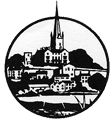Tour of Buckinghamshire Country Houses (10th and 11th September 2014)
Twenty-two members spent a very pleasant and interesting two days visiting three historic and varied National Trust properties, with their prolific collections of fine art to admire and impressive gardens to explore. By happy chance the Indian summer accorded us excellent weather throughout.
Claydon House
After a fairly early start, our coach took us first to the Verney family's Claydon House near Buckingham, a grand and imposing late-18th C. edifice - even after some two thirds had to be demolished not very long after its construction because the money had run out and it was too expensive to maintain. The somewhat austere, massive exterior belies an interior extravaganza of rococo architecture: unusually, many of the intricate ceilings and wall decorations are carved wood rather than plasterwork, the work of Luke Lightfoot, the most talented wood carver of the era. A spectacular, cantilevered, parquetry staircase is another impressive feature. As well as many portraits and other pictures, there are rooms dedicated to artefacts and records from the family's history, including mementos of Florence Nightingale, who stayed at Claydon extensively after her sister married into the Verney family.
After a morning's wealth of art and architecture, a leisurely lunch in the sunshine at The Carriage House Restaurant in the grounds was hard to resist - and some of us didn't.
Ascott
Moving on the fifteen or so miles to Ascott, in Wing, brought us to Leopold de Rothschild's "hunting box", set just north-west of the Dunstable Downs. The house itself is sprawling, and comfortable rather than grand, but the extensive terraced gardens - with unspoilt views over a landscape probably little changed since 1873, when it was bought and extended - mainly comprise settings of mature trees (majestic cedars by the dozen) around yew hedges, lawns and fountains, with a few small areas of plants and flowers. There is also a more modern garden to the front of the house, a tribute by the present tenant, Sir Evelyn de Rothschild, to his second wife, formerly Lynn Forester, a successful businesswoman.
Inside the house is a superb collection of Dutch landscapes; English paintings, including Gainsboroughs and many Stubbs racehorses; English furniture; Chinese ceramics; and much more.
Overnight
The Holiday Inn, Aylesbury, by contrast to what had gone before, was somewhat prosaic but it was well-placed geographically, quiet and comfortable, if not noted for its cuisine. It served our purpose and it retrieved itself a little by providing a better-than-average breakfast.
Waddesdon Manor
Waddesdon, five miles from Aylesbury and another Victorian-age Rothschild estate (Baron Ferdinand of that ilk), is one of the National Trust's premier properties, but operated by a Rothschild trust. The mile or more of carriage-drive up through rolling parkland and woodland gives an inkling of what is to come, but the elegant, enormous, if extravagant, French chateau, with its two hundred yards of immaculate, billiard table lawns in front which springs into view after the last corner is turned, is still a splendour difficult to take in all at once.
Our timed entry to the house was at noon so there was an hour and a half available to explore the immediate grounds, including a huge and colourful aviary of tropical birds and the immense parterre at the other side of the house. The latter was blaze of colour, mainly yellow and blue flowers in their network of clipped box, with precise bay topiary and yew hedges that must take a few man-years to maintain. At the centre is an elaborate fountain which would not look out of place at Versailles. The whole setting is a perfect foil for the size and the exuberant features of the south elevation of the house, and the views over the Vale of Aylesbury.
If the outside was impressive, the inside and its collection of fine art was approaching superlative: room after room of English and Dutch paintings; the very best French carpets, tapestries and furniture; elaborate plasterwork; objets d'art; and exquisite Sèvres porcelain tableware by the score. It didn't come cheap!
Again, there was a very pleasant restaurant in a corner of the house - a cut above the average National Trust offering, good though that is. There was time for a late lunch - with wines from the French branch of the family, where else? - before a last look in the shop and the wine store and a walk back to the coach, which, after an uneventful journey, brought us back to Ross before five o'clock.
Our thanks are due to Norman Allen Group Travel, who, in their normal efficient way, handled the travel and hotel arrangements, based on our choice of venues.
Philip Blunden

